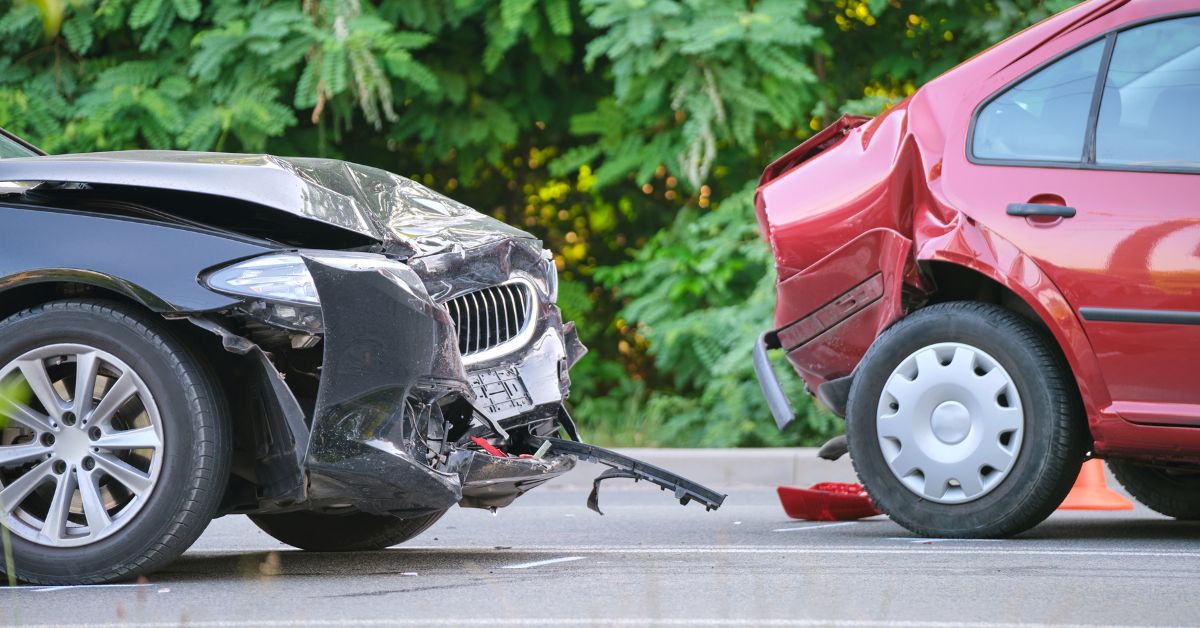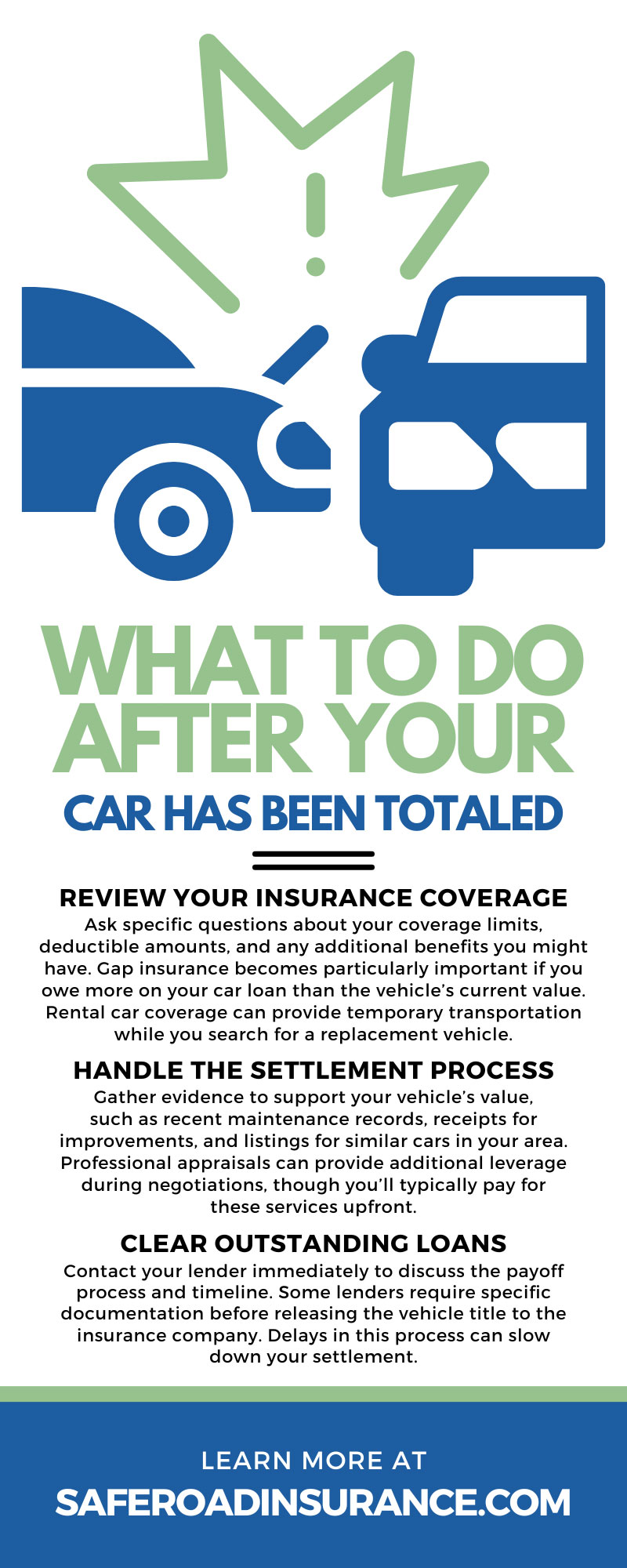
Getting the call that your car has been declared a total loss can feel overwhelming. Your vehicle has been damaged beyond economical repair, and now you face a mountain of paperwork, insurance negotiations, and the challenge of finding new transportation. But the process doesn’t have to be confusing if you know the right steps to take.
A total loss occurs when repair costs exceed a certain percentage of your car’s actual cash value, typically between 70 and 80 percent, depending on your state and insurance company. This threshold exists because insurers recognize that extensive, high-cost repairs often lead to ongoing mechanical issues and diminished vehicle reliability.
Knowing what to do after your car has been totaled can ease the stress of the situation and streamline the process. Making the right decisions will impact your financial recovery and your ability to get back on the road safely.
Review Your Insurance Coverage
Contact your insurance company immediately to understand your policy’s total loss provisions. Your adjuster will explain how they calculated your vehicle’s actual cash value and walk you through the settlement process.
Ask specific questions about your coverage limits, deductible amounts, and any additional benefits you might have. Gap insurance becomes particularly important if you owe more on your car loan than the vehicle’s current value. Rental car coverage can provide temporary transportation while you search for a replacement vehicle.
Document everything during your conversations with insurance representatives. Request written confirmation of settlement offers, and keep detailed records of all communications. This documentation protects you if disputes arise later in the process.
Handle the Settlement Process
Insurance companies determine your vehicle’s value using various methods, including comparable sales data, vehicle condition reports, and market analysis tools. You have the right to review and challenge their valuation if you believe it’s too low.
Gather evidence to support your vehicle’s value, such as recent maintenance records, receipts for improvements, and listings for similar cars in your area. Professional appraisals can provide additional leverage during negotiations, though you’ll typically pay for these services upfront.
The settlement amount represents your vehicle’s actual cash value, minus your deductible. It should cover most of your vehicle replacement costs, though you might need additional funds depending on current market prices.
Clear Outstanding Loans
If you financed your vehicle, the insurance settlement goes directly to your lender first. The remaining balance, if any, gets paid to you. However, if you owe more than the settlement amount, you are responsible for the difference unless you have gap insurance.
Contact your lender immediately to discuss the payoff process and timeline. Some lenders require specific documentation before releasing the vehicle title to the insurance company. Delays in this process can slow down your settlement.
Gap insurance covers the difference between your loan balance and the vehicle’s actual cash value. If you don’t have this coverage, you’ll need to pay the remaining loan balance out of pocket on top of paying for a replacement vehicle.
Manage Personal Property
Remove all personal belongings from your vehicle before the insurance company takes possession. Create a detailed inventory of any items that were damaged in the accident, as your insurance policy might cover personal property losses.
Check your vehicle thoroughly, including the trunk, glove compartment, and storage areas. Don’t forget items like registration documents, insurance cards, or maintenance records that you might need for your replacement vehicle.
Submit separate claims for damaged personal property if your auto policy includes this coverage. Electronics, clothing, and other personal items often have different coverage limits and deductibles than your vehicle itself.
Navigate the Replacement Vehicle Process
One of the main things you should do after your car has been totaled is consider your long-term transportation needs and budget constraints. Start shopping for a replacement vehicle as soon as possible, especially if your rental car coverage has time limits.
Research makes and models that fit your budget and transportation needs before visiting dealerships. Consider whether you want to buy or lease your next vehicle. Market conditions, your financial situation, and personal preferences all influence this decision.
Get preapproved for financing from banks or credit unions before shopping. This gives you negotiating power and helps you understand your true budget. Many people need affordable automobile insurance for their replacement vehicle, so factor insurance costs into your overall budget when selecting your next car.
Address Tax and Registration Issues
Cancel your registration and return license plates according to your state’s requirements. Some states require you to surrender plates immediately, while others allow you to transfer them to a replacement vehicle.
Contact your local DMV to understand your area’s requirements. You might be eligible for registration fee refunds if you paid for a full year and the total loss occurred early in the registration period.
Keep copies of all documentation related to the total loss for tax purposes. In some situations, casualty losses can provide tax benefits, particularly if the loss exceeds your insurance coverage.
Understand Insurance Rate Implications
A total loss claim can impact your future insurance premiums, especially if you were at fault for the accident. Shop around for different insurers when purchasing coverage for your replacement vehicle, as companies weigh claims history differently. Saferoad Insurance can help you find the best coverage within your budget.
Consider bundling your auto insurance with other policies like homeowners’ or renters’ insurance to increase discounts. Many companies offer substantial savings for multiple policyholders.
Prepare for Future Protection
Use this experience to estimate your insurance coverage needs. Consider increasing your liability limits, adding comprehensive and collision coverage if you didn’t have them, or purchasing gap insurance for your next vehicle.
Document the total loss process for future reference. Keep records of settlement amounts, replacement costs, and any challenges you encountered. This information helps you make better insurance decisions and prepares you for potential future claims.
Review your emergency fund, and consider setting aside money for transportation emergencies. Having readily available funds can bridge the gap between a total loss and finding suitable replacement transportation.
Make Your Next Steps Count
Dealing with a totaled vehicle requires patience and attention to detail, but following these steps helps guarantee you receive fair compensation and get back on the road safely. The key lies in staying organized, understanding your rights, and making good decisions about your replacement vehicle and insurance coverage.
Take time to research your options thoroughly rather than rushing into decisions. The choices you make now could impact your transportation and financial situation for years to come. Contact Saferoad Insurance Services to discuss coverage options for your replacement vehicle, making sure you’re properly protected for the future.
